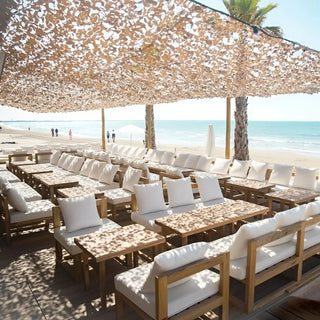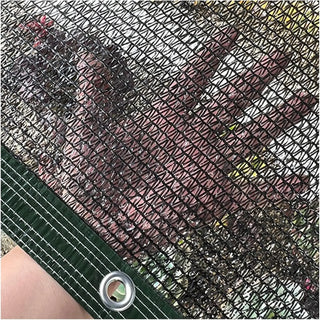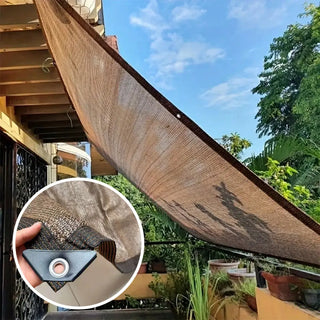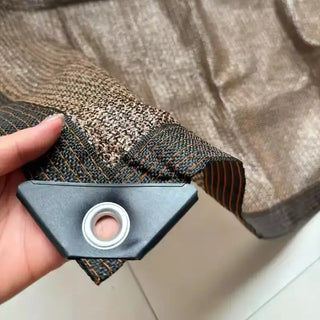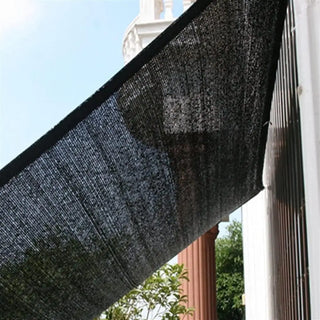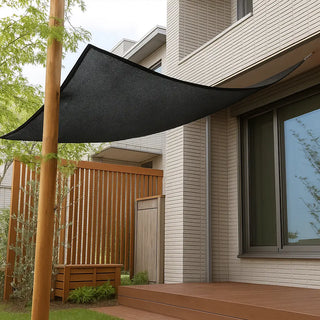Shade Cloth
Filter
30% Shade Cloth
Regular price
$26.90
from $21.90
Save up to 21%
- Unit price
- / per
Regular price
$26.90
from $21.90
Save up to 21%
- Unit price
- / per
In stock
90% Shade Cloth
Regular price
$36.90
from $29.90
Save up to 21%
- Unit price
- / per
Regular price
$36.90
from $29.90
Save up to 21%
- Unit price
- / per
In stock
50% Shade Cloth
Regular price
$26.90
from $21.90
Save up to 21%
- Unit price
- / per
Regular price
$26.90
from $21.90
Save up to 21%
- Unit price
- / per
In stock
You're viewing 3 of 3 products
Shade cloth is an essential shade solution for anyone wanting to protect their plants, patios, or outdoor structures from intense sunlight. Whether you’re looking for sun protection in a greenhouse, a stylish pergola patio, or just want to keep your backyard cool, shade cloth provides an effective barrier that helps reduce heat, improve ventilation, and moderate temperatures.
Available in a wide range of shade percentages like 30 shade, 50 shade, 70 shade, and even 95 shade, it’s a flexible product that fits many needs. Let’s explore how to choose the right shade cloth and unlock all the benefits this versatile fabric has to offer for gardens, homes, and businesses.
What is shade cloth and why it matters?
Definition and function
Shade cloth is a specialized fabric designed to block a specific percentage of sunlight, helping to keep spaces cool and protect delicate plant growth. Unlike regular cloth, it’s engineered to allow air flow and water penetration while shielding plants or outdoor furniture from harmful rays. It’s commonly used in greenhouse shade cloth, shade houses, hoop houses, and for creating shade structures over patios and gardens.
It’s also a popular product for improving comfort in outdoor spaces like decks or pergola patios. From heavy duty commercial installations to small backyard projects, shade cloth is a versatile solution that serves a wide variety of purposes.
How shade cloth works?
Shade cloth works by blocking sunlight to reduce heat and UV exposure, while still allowing air and moisture to flow through the mesh. This balance is critical for healthy plant growth, as it prevents heat stress while letting plants access the light they need.
The material often comes as knitted shade cloth or woven shade cloth, each offering different levels of durability and flexibility. Shade cloth can be cut to fit custom sizes, making it easy to install for any structure. It’s a perfect option for protecting plants, cooling patios, and creating privacy screens for outdoor spaces.
Main benefits
One of the biggest benefits of shade cloth is its ability to moderate temperatures and create a comfortable space for people and plants alike. In gardens, it prevents scorching, promotes steady growth, and helps manage moisture by reducing water evaporation. For homeowners, it offers excellent sun protection over patios and pergolas, keeping the area cooler and more enjoyable during summer months.
In addition, it’s often used to protect outdoor furniture, manage conditions in greenhouses, and even provide privacy. The wide selection of colors, shade percentages, and models allows users to customize their installations for perfect results.
Types of shade cloth: materials, construction, and performance
Material types: HDPE vs. polyester vs. natural fibers
Most shade cloth products are made from HDPE, a durable and UV-resistant plastic known for long life under harsh conditions. Polyester offers a softer fabric feel and is sometimes used for more decorative shade sails in outdoor spaces. Natural fibers like cotton or jute are less durable and tend to degrade faster but can offer aesthetic appeal for temporary installations.
HDPE is typically the material of choice for greenhouse outdoor pergola applications because it is lightweight, resistant to tear and rain, and easy to clean. Choosing the right material depends on your specific needs, budget, and climate.
Fabric construction: knitted vs. woven vs. Rachel knit
Shade cloth comes in different constructions, each impacting durability, performance, and installation. Knitted shade cloth is flexible, allowing it to stretch slightly without tearing, making it easy to install and resistant to damage. Woven shade cloth offers a more rigid structure, ideal for areas where strength and shape retention are essential.
Rachel knit is a specialized pattern providing high tensile strength and reduced fraying along the edge when cut. Knowing the type of shade cloth construction helps ensure your project lasts longer under varying conditions. This is crucial for larger installations, like commercial shade structures or shade cloths covering greenhouses.
UV block rates and density percentages explained
A key factor in selecting shade cloth is its shade percentage, indicating how much sunlight it can block. 30 shade cloth filters about 30% of light, suitable for plants needing high sun exposure like lettuce. 50 shade is a common choice for many crops or outdoor spaces seeking balance between sun and cooling.
70 shade or 95 shade provides significant sun protection, perfect for delicate plants, or creating cooler patios and privacy screens. A table comparing shade levels helps people select the correct cloth for their purpose. Understanding the right percentage ensures you protect your plants or spaces without sacrificing necessary light for growth.
Choosing the right shade cloth for your needs
Factors to consider
When you’re ready to buy shade cloth, think about several factors to make the best purchase. Start with your local sunlight intensity and climate. Some plants thrive under partial shade, while others are shade loving and need higher levels of sunblock net for garden protection. Consider the size of your area, from small patios to large shade houses.
Your aesthetic preferences whether you prefer black shade cloth, green shade, white shade cloth, or even bright colors like blue or red also influence your decision. Lastly, budget matters. While cheap options might be tempting, higher-quality cloths offer better durability, service, and longer lifespan, making them more cost-effective over time.
Shade cloth colors: beyond aesthetics
Color isn’t just about looks; it affects heat absorption and light reflection. Dark colors like black or dark green absorb more heat, making them excellent for high sun protection, though they may increase surface temperatures. Lighter shades such as white shade cloth or tan reflect light, helping keep both plants and spaces cooler.
Specialty fabrics like aluminet shade cloth reflect sunlight effectively and can lower temperatures significantly, making them ideal for sensitive crops or greenhouses. Studies show different colors influence photosynthesis rates, which affects plant growth and yield. Choosing the right color helps manage temperature and light levels precisely.
Calculating shade cloth size and coverage
Accurately sizing your shade cloth ensures you cover your entire structure without gaps. Measure the length and width of the space and add extra allowance for tensioning and grommets. Remember that knitted cloth may stretch, while woven cloth stays more rigid.
Allowing airflow around the edges is vital for ventilation and cooling. Many online shops and hardware stores offer shade cloth with grommets for easy hanging. Whether covering a greenhouse, pergola patio, or backyard area, choosing the right size guarantees better performance and a neater appearance. If you’re unsure, it’s smart to share your measurements with a store offering custom-cut services.
When to choose shade sails instead?
Sometimes shade sails are a better fit than traditional shade cloth, especially for stylish outdoor spaces. These sails come in eye-catching shapes and colors, adding modern design flair while providing effective sun protection. However, they are usually more expensive and might be less customizable in terms of shade percentage.
Combining shade sails with shade cloths is a great way to balance aesthetics and practicality, such as using sails for patios and cloth for greenhouse or garden use. This hybrid approach creates versatile spaces for people to relax, garden, or entertain, while ensuring proper cooling and sunlight management.
Installation and maintenance
Installation basics
Installing shade cloth is usually simple, especially when using accessories like clips, grommets, or track systems. For greenhouse shade cloth, it’s often best installed above the roof to create an air gap, reducing internal heat. On pergolas, securing cloth with mesh tarp with grommets or cables makes it easy to install and remove seasonally.
Heavy duty models may require professional help due to weight or size. Ensure tension is even along the edge to prevent sagging and extend the life of your shade cloth. Choosing custom sizes from stores helps avoid fitting problems and ensures better wind resistance.
Maintenance and cleaning
Keeping shade cloth clean is crucial for maintaining its sun protection abilities. Dust, pollen, and debris can clog the mesh, reducing light passage and air flow. Regular cleaning with a gentle hose spray or mild soap solution works well, especially for hdpe cloths, which are resistant to mold and mildew.
For heavier stains, use a soft brush but avoid harsh chemicals that could damage the material. Proper drying is essential before storing cloth away. Many users find it easier to hang shade cloth seasonally, removing it before winter rain or snow for maximum durability.
Troubleshooting common problems
Even durable shade cloth can develop issues like tears, stretching, or wind damage. Small holes are often fixable using patches or by sewing with strong thread. Sagging might indicate improper installation or tension loss. Heavy duty cloths reduce this risk, but correct installation is still key.
In high-wind areas, it’s wise to use stronger attachments like clips, cables, or grommets to prevent the cloth from detaching. Regular inspection helps identify problems early. Remember, a well-maintained shade cloth remains an effective solution for gardens, patios, or any outdoor space, saving you money on replacements and ensuring continuous sun protection.
Creative and unexpected uses for shade cloth
Urban gardening and vertical gardens
In urban environments, shade cloth helps transform small spaces into thriving gardens. Green shade cloth protects rooftop plants from extreme heat while letting light and air flow for steady plant growth. Vertical gardens often use shade fabric as a screen to support climbing plants while shielding them from harsh sunlight.
These creative uses make it easier to manage limited space and maintain healthy greenery. Using vibrant colors like red or blue also adds visual interest to urban settings. For those passionate about sustainability, shade netting offers an innovative way to green cities.
Outdoor event design
Event planners are increasingly turning to shade products for festivals, markets, and weddings. Sun shade fabric provides sun protection and cooling, creating pleasant outdoor spaces for guests. Custom designs let businesses share their logos or patterns, turning a functional shade cloth into a marketing tool.
Easy-to-use mesh tarps with grommets make temporary installations simple and effective, allowing quick set-up and removal. These creative uses highlight how shade cloth isn’t limited to gardens—it’s also a tool for creating memorable, comfortable experiences. Whether you’re hosting a backyard party or a large event, shade cloth is a perfect addition to your planning toolkit.
Wildlife and habitat applications
Conservationists use shade cloth to create protective environments for wildlife. In zoos or greenhouse habitats, shade cloth helps regulate temperature and light for animals sensitive to sun exposure. Aluminet shade cloth is particularly useful for reducing heat and glare in animal enclosures.
These applications show how shade cloth extends beyond gardening into ecological improvement projects, proving it’s a truly versatile product. By helping manage environmental conditions, it contributes to healthier ecosystems and better living conditions for wildlife. It’s a powerful reminder that the benefits of shade cloth reach far beyond human uses.
Engineering applications
On construction sites, shade cloth serves as dust control screens or privacy screens, shielding neighboring areas from debris. Engineers also use it as wind barriers around scaffolding, protecting workers and improving safety. In some industrial facilities, it’s applied for temperature control and noise reduction.
The flexibility of shade cloth, whether in knitted or woven form, makes it a cost-effective, heavy duty solution for diverse applications. For large-scale projects, purchasing shade cloth rolls online or from local supplies stores ensures consistent quality and availability. This industrial use emphasizes how versatile and indispensable shade cloth has become across many sectors.
Artistic and architectural installations
Artists and architects are finding fresh inspiration in shade cloth, using it in sculptures and innovative building designs. Shade cloth can be stretched into flowing forms, adding texture and light play to public spaces. Whether it’s a large-scale canopy installation or a delicate sculpture, the wide range of colors and types from aluminet to vibrant red or classic black offers endless creative possibilities.
It’s a great example of how practical materials can cross into artistic expression. In modern architecture, shade cloth contributes both to energy efficiency and unique aesthetics, proving that functional products can also be beautiful.
Cost, availability, and where to buy
Pricing guide
Shade cloth is sold by the foot, yard, or in large rolls, with prices influenced by shade percentage, material, and color. A basic black shade cloth or green shade cloth can start around $0.20–$0.50 per square foot, while specialty types like aluminet shade cloth or heavy duty models can exceed $1.50 per square foot.
For larger installations, buying in bulk often reduces costs significantly. Comparing prices online vs. local hardware stores helps find the best deal. Quality, warranty, and supplier service should also factor into your decision, ensuring you don’t sacrifice durability for a lower initial cost.
Online vs. local retail
Shoppers can find shade cloth online from platforms like Amazon, greenhouse supplies websites, or specialty stores, offering a broad range of shade products and custom options. Online buying makes it easier to compare specs, read shade verified purchase reviews, and even add to cart from home.
However, local hardware stores and garden centers let you examine the fabric, feel its quality, and ask for service advice. Some local shops even cut cloth to custom sizes. The choice between online convenience and local service depends on your project’s scale and personal preference.
How to evaluate quality when shopping?
Not all shade cloths offer the same quality or durability. Look for UV protection ratings, high gsm weight (grams per square meter), and reputable brands. Check whether the cloth is easy to install and resistant to tear, wind, and harsh conditions. Many premium products come with warranties, indicating confidence in durability.
Customer reviews labeled shade verified purchase provide honest feedback about real-world performance. Don’t overlook hardware accessories like grommets, which make it easier to hang shade cloth securely. Investing in a reliable product saves money and effort in the long run, ensuring you get the full benefit of your shade investment.
Frequently asked questions (FAQs)
What percentage of shade cloth do I need for tomatoes?
Tomatoes thrive under 30-50% shade cloth, depending on climate. In hot areas, 50% is a safer option to reduce heat while allowing enough light for fruit growth.
Does shade cloth reduce heat or just light?
It does both. Shade cloth reduces sunlight and blocks heat, helping keep outdoor spaces and plants cooler. The right percentage and color make a big difference in temperature control.
Which color of shade cloth is best for my plants?
For most crops, black or green is common, but lighter shades like white reflect more heat, keeping spaces cooler. Aluminet shade cloth is excellent for greenhouses, offering reflective cooling benefits.
Can shade cloth withstand snow or hail?
While heavy duty cloths are stronger, most are not designed for heavy snow loads. It’s best to remove shade cloth in winter to avoid damage from rain, snow, or ice.
How long does shade cloth last?
Quality shade cloth made from HDPE can last 5-15 years depending on UV exposure, installation, and care. Cheaper cloths often degrade faster under intense sunlight.
Is shade cloth recyclable?
Many HDPE shade cloths are recyclable, but check local rules. Some suppliers accept returns for recycling or offer trade-in programs to reduce environmental impact.
Can I use shade cloth indoors?
Yes! Shade cloth works well as privacy screens, partitions, or decorative elements in indoor spaces. Just choose a color and type that matches your decor.
How do I keep shade cloth from flapping in the wind?
Proper installation with tensioning, clips, and grommets helps prevent flapping. Knitted fabrics are also better at handling wind due to their flexibility.
We ship your order within 48h.
You have 14 days to change your mind and get a full refund.
Pay securely with PayPal, Credit Card or Shop Pay.
We're here for you! Our team is available to answer your questions from Monday to Saturday.

